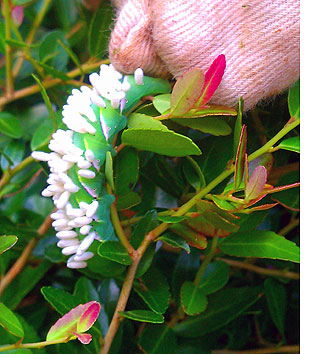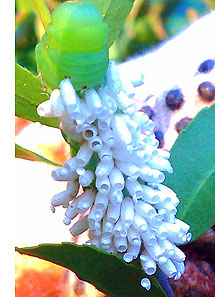"What IS that?!?!"
 I asked as I was pulling invasive plants from the Boxwoods planted behind Hewlett Lodge. The shrubs seemed to be host to a variety of invasive species- Honeysuckle waving defiantly from the top, Elaeagnus' tentacle-like stems sprouting from the sides and English Ivy trying to sneak in underfoot. But this… THIS was something that brought the term "invasive" to a whole new level.
I asked as I was pulling invasive plants from the Boxwoods planted behind Hewlett Lodge. The shrubs seemed to be host to a variety of invasive species- Honeysuckle waving defiantly from the top, Elaeagnus' tentacle-like stems sprouting from the sides and English Ivy trying to sneak in underfoot. But this… THIS was something that brought the term "invasive" to a whole new level.
What I saw appeared to be a big green caterpillar with white eggs all over it. I was perplexed so I grabbed my camera, a magnifying glass, and some coworkers to check out the weird caterpillar. A little research gave us a lot of information!
What we'd discovered on our Boxwood was, in fact, a caterpillar- Manduca sexta, or the Tobacco Hornworm. What was on its back, however, was not eggs but rather several little cocoons. The Tobacco Hornworm was playing host to young Cotesia congregata, a type of parasitic wasp. Adult female wasps locate the caterpillars and use their ovipositor (from Latin ovum "egg" and positor "one who deposits") to sting the hornworm.
 With the sting, the wasp injects eggs along with specialized viruses into the caterpillar. The viruses shut down the caterpillar's internal defenses and allow the eggs to grow and eventually hatch. The tiny wasps begin eating the caterpillar's organs until they become large enough to burrow their way out, at which point they spin the tiny silken cocoons visible in the photo. After 3-4 days, they emerge from the cocoons and the caterpillar dies a few days later.
With the sting, the wasp injects eggs along with specialized viruses into the caterpillar. The viruses shut down the caterpillar's internal defenses and allow the eggs to grow and eventually hatch. The tiny wasps begin eating the caterpillar's organs until they become large enough to burrow their way out, at which point they spin the tiny silken cocoons visible in the photo. After 3-4 days, they emerge from the cocoons and the caterpillar dies a few days later.
While this seems like an awful fate to meet, home gardeners should be appreciative of this instance of biological pest control. While its name may be deceiving, the Tobacco Hornworm, and its cousin Manduca quinquemaculata, the Tomato Hornworm, feeds on plants of the genus Solanum, which includes tomatoes, eggplants, peppers, potatoes, and of course, tobacco. Boxwood is not in the Solanum genus, and it's unclear why this caterpillar decided to make his home in ours. It can defoliate a tomato plant within just a couple days, hence their Latin name, Manduca, which means "glutton" and because of their green color are very difficult to see on the plant.
Hornworms can be a nuisance, but nature's pesticide can be very beneficial: if you find one in your garden with the wasp cocoons on its back, leave it there! When the wasps emerge from the cocoons, they will seek out other hornworms in the area and infect them, too!Because hornworms are well camouflaged, they can be difficult to see on plants. If you notice tomato plants losing foliage (generally from the top down) you can look for other signs of the hornworms- one good indicator is their frass (droppings) on lower leaves.
When these hornworms reach maturity and are not preyed upon by wasps, they transform into Hawkmoths, which are some of the fastest moths, with speeds up to 30 miles per hour. They are sometimes confused with hummingbirds, due to their quickly fluttering wings and habit of hovering over flowers while feeding.

